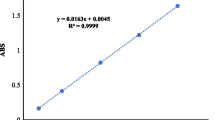Abstract
The mechanism of decolorization of crude maize and sunflower oils was studied by means of adsorption of β-carotene by a low-grade bentonite, containing mixed-layered illite-smectite. Decolorization depends on temperature and the time required for equilibrium decreases with increasing temperature. The study of the kinetics of adsorption showed that decolorization of maize oil is a first-order process which occurs in two steps: a first fast step with higher activation energy (25.6 kJ mol−1), indicating the influence of a chemical interaction between the pigment and the clay surface, followed by a second slow step with low activation energy (12.3 kJ mol−1), characteristic of physical adsorption on the previously adsorbed molecules. Decolorization of sunflower oil is also a first-order process, described by a single mechanism with intermediate activation energy (19.0 kJ mol−1). Adsorption isotherms of decolorization of maize oil follow the Freundlich equation, indicating the existence of heterogeneous adsorption sites on the solid’s surface. Heterogeneity is attributed both to different active centers on the smectite surface (Brönsted and Lewis centers) and to the different phases present in bentonite, such as illitic layers and clinoptilolite, which also have active centers on their surfaces.
Similar content being viewed by others
References
Adams, J.M. (1987) Synthetic organic chemistry using pillared, cation-exchanged and acid-treated montmorillonite catalysts — A review. Applied Clay Science, 2, 309–342.
Baharin, B.S., Abdul Rahman, K., Abdul Karim, M.I., Oyaizu, T., Tanaka, K., Tanaka, Y. and Takagi, S. (1998) Separation of palm carotene from crude palm oil by adsorption chromatography with a synthetic polymer adsorbent. Journal of American Oil Chemists Society, 75, 399–404.
Boki, K., Kubo, M., Wada, T. and Tamura, T. (1992a) Bleaching of alkali-refined vegetable oils with clay minerals. Journal of American Oil Chemists Society, 69, 233–236.
Boki, K., Kubo, M., Kawasaki, N. and Mori, H. (1992b) Adsorption isotherms of pigments from alkali-refined vegetable oils with clay minerals. Journal of American Oil Chemists Society, 69, 372–378.
Boyd, S.A. and Jaynes, W.F. (1994) Role of layer charge in organic contaminant sorption by organo-clays. Pp. 47–77 in: Layer Charge Characteristics of 2:1 Silicate Clay Minerals (A.R. Mermut, editor). CMS workshop lectures, 6, Clay Minerals Society, Bloomington, Indiana.
Brimberg, U.I. (1982) Kinetics of bleaching of vegetable oils. Journal of American Oil Chemists Society, 59, 74–78.
Christidis, G.E., Scott, P.W. and Dunham, A.C. (1997) Acid activation and bleaching capacity of bentonites from the islands of Milos and Chios, Aegean, Greece. Applied Clay Science, 12, 329–347.
Christidis, G.E., Kosiari, S. and Petavratzi, E. (2002) Acid activation and bleaching capacity of bentonites from the Troodos ophiolite, Cyprus. Proceedings of the 12th International Clay Conference, in press.
Drever, J.I. (1997) The Geochemistry of Natural Waters. Surface and Groundwater Environments. Prentice Hall, New Jersey, 436 pp.
Girgin, I., Gündoglu, M.N., Ata, S. and Yörükoglu, A. (1996) Oil decolorization properties of the Emirler clinoptilolite (Bigadic, Turkey). Mineralium Deposita, 31, 584–588.
Kheok, S.C. and Lim, E.E. (1982) Mechanism of palm oil bleaching by montmorillonite clay activated at various acid concentrations. Journal of American Oil Chemists Society, 59, 129–131.
Khoo, L.E., Morsingh, F. and Liew, K.Y. (1979) The adsorption of β-carotene I by bleaching earths. Journal of American Oil Chemists Society, 59, 672–675.
Laidler, K.J. (1987) Chemical Kinetics, 3rd edition. Harper & Row, New York, 531 pp.
Latip, R.A., Baharin, B.S., Che Man, B.S. and Abdul Rahman, R. (2000) Evaluation of different types of synthetic adsorbents for carotene extraction from crude palm oil. Journal of American Oil Chemists Society, 77, 1277–1281.
Morgan, D.A., Shaw, D.B., Sidebottom, T.C., Soon, T.C. and Taylor, R.S. (1985) The function of bleaching earths in the processing of palm, palm kernel and coconut oils. Journal of American Oil Chemists Society, 62, 292–299.
Odom, I.E. (1984) Smectite clay minerals: properties and uses. Philosophical Transactions of the Royal Society London, A311, 391–409.
Rhodes, C.N. and Brown, D.R. (1992) Structural characterization and optimization of acid-treated montmorillonite and high-porosity silica supports for ZnCl2 alkylation catalysts. Journal of the Royal Society of Chemistry Faraday Transactions, 88, 2269–2274.
Rupert, J.P., Granquist, W.T. and Pinnavaia, T.J (1987) Catalytic properties of clay minerals. Pp. 275–318 in: Chemistry of Clays and Clay Minerals. (A.C.D. Newman editor). Monograph 6, Mineralogical Society, London.
Sarier, N. and Güler, C. (1988) β-carotene adsorption on acid activated montmorillonite. Journal of American Oil Chemists Society, 66, 917–923.
Sarier, N. and Güler, C. (1989) The mechanism of β-carotene adsorption on activated montmorillonite. Journal of American Oil Chemists Society, 65, 776–779.
Siddiqui, M.K.H. (1968) Bleaching Earths. Pergamon Press, Oxford, UK, pp. 32–55.
Srasra, E., Bergaya, F., van Damme, H. and Arguib, N.K. (1989) Surface properties of an activated bentonite — decolourization of rapeseed oil. Applied Clay Science, 4, 411–421.
Stoch, L., Bahranowski, K. and Gatarz, Z. (1979) Bleaching properties of non-bentonitic clay materials and their modification: II. Bleaching ability of natural and activated Krakowiec clays from Machow. Mineralogia Polonica, 10, 21–38.
Taylor, D.R., Jenkins, D.B. and Ungermann, C.B. (1989) Bleaching with alternative layered minerals: A comparison with acid activated montmorillonite for bleaching soyabean oil. Journal of American Oil Chemists Society, 66, 334–341.
Zschau, W. (2001) Bleaching of edible fats and oils. European Journal of Lipid Science and Technology, 103, 505–551.
Author information
Authors and Affiliations
Corresponding author
Rights and permissions
About this article
Cite this article
Christidis, G.E., Kosiari, S. Decolorization of Vegetable Oils: A Study of the Mechanism of Adsorption of β-Carotene by an Acid-Activated Bentonite from Cyprus. Clays Clay Miner. 51, 327–333 (2003). https://doi.org/10.1346/CCMN.2003.0510309
Received:
Revised:
Published:
Issue Date:
DOI: https://doi.org/10.1346/CCMN.2003.0510309




